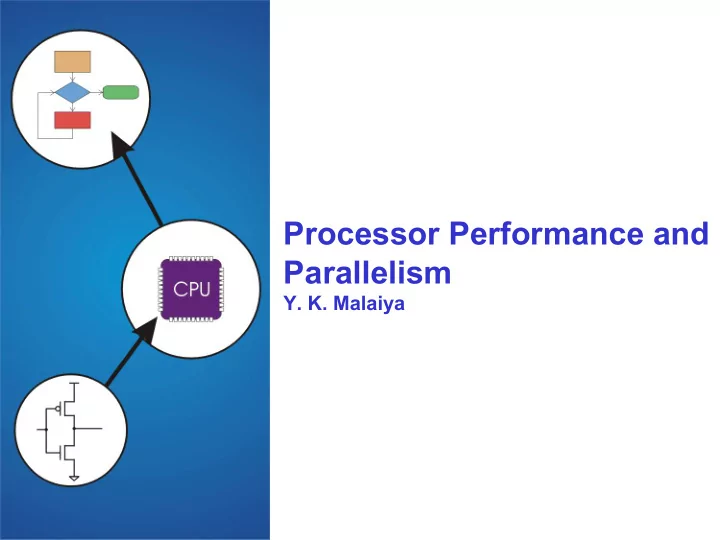

Processor Performance and Parallelism Y. K. Malaiya
Processor Execution time The time taken by a program to execute is the product of n Number of machine instructions executed n Number of clock cycles per instruction (CPI) n Single clock period duration = ´ Clock Cycles Instructio n Count Cycles per Instructio n = ´ ´ CPU Time Instructio n Count CPI Clock period Example: 10,000 instructions, CPI=2, clock period = 250 ps = ´ ´ CPU Time 1 0 , 000 instructio ns 2 250 ps - - 4 12 6 = ´ ´ = 10 2 250 . 10 5 . 10 sec . 2
Processor Execution time Instruction Count for a program = ´ ´ CPU Time Instructio n Count CPI Clock Cycle Time n Determined by program, ISA and compiler Average Cycles per instruction (CPI) n Determined by CPU hardware n If different instructions have different CPI Average CPI affected by instruction mix Clock cycle time (inverse of frequency) n Logic levels n technology 3
Reducing clock cycle time Has worked well for decades. Small transistor dimensions implied smaller delays and hence lower clock cycle time. Not any more. 4
CPI (cycles per instruction) What is LC-3 cycles per instruction? Instructions take 5-9 cycles (p. 568), assuming memory access time is one clock period. n LC-3 CPI may be about 6*. (ideal) No cache, memory access time = 100 cycles? Load/store instructions n LC-3 CPI would be very high. are about 20-30% Cache reduces access time to 2 cycles. n LC-3 CPI higher than 6, but still reasonable. 5
Parallelism to save time Do things in parallel to save time. Approaches: • Instruction level parallelism Ø Pipelining: Divide flow into stages. Let instructions flow into the pipeline. Ø Multiple issue: Fetch multiple instructions at the same time • Concurrent processes or thread (Task-level parallelism) Ø For true concurrency, need extra hardware – Multiple processors (cores) or – support for multiple thread Demo: Threads in Mac 6
Pipelining Analogy Pipelined laundry: overlapping execution • Parallelism improves performance n Four loads: n time = 4x2 = 8 hours n Pipelined: n Time in example = 7x0.5 = 3.5 hours n Non-stop = 4x0.5 = 2 hours. 7
Pipeline Processor Performance Single-cycle (T c = 800ps) Pipelined (T c = 200ps) 8
Pipelining: Issues Cannot predict which branch will be taken. n Actually you may be able to make a good guess. n Some performance penalty for bad guesses. Instructions may depend on results of previous instructions. n There may be a way to get around that problem in some cases. 9
Instruction level parallelism (ILP): Pipelining is one example. Multiple issue: have multiple copies of resources • Multiple instructions start at the same time • Need careful scheduling Ø Compiler assisted scheduling Ø Hardware assisted (“superscaler”): “dynamic scheduling” – Ex: AMD Opteron x4 – CPI can be less than 1!. 10
Task Parallelism Program is divided into tasks that can be run in parallel Concurrent Processes n Can run truly in parallel if there are multiple processors, e.g. multi-core processors Concurrent Threads n Multiple threads can run on multiple processors, or n Single processor with multi-threading support (Simultaneous Multithreading) Process vs thread n All information resources for a process are private to the process. n Multiple threads within a process have private registers & stack, but not address space. 11
Task Parallelism Program is divided into tasks that can be run in parallel Example: A program needs subtasks A,B,C,D. B and C can be run in parallel. They each take 200, 500, 500 and 300 nanoseconds. Without parallelism: total time needed = 200+500+500+300 = 1500 ns. With Task level parallelism: 200 +500 (B and C in parallel) +300 = 1000 ns. A B C D A B D C 12
Task Parallelism 13
Flynn’s taxonomy Michael J. Flynn, 1966 Data Streams Single Multiple Instruction Single SISD : SIMD : MMX/SSE Streams Intel Pentium 4 instructions in x86 Multiple MISD : MIMD : eg. Multicore No examples today Intel Xeon e5345 n Instruction level parallelism is still SISD n SSE (Streaming SIMD Extensions): vector operations n Intel Xeon e5345: 4 cores n Does not model Instruction level/task level parallelism 14
Multi what? Multitasking: tasks share a processor Multithreading: threads share a processor Multiprocessors: using multiple processors n For example multi-core processors (multiples processors on the same chip) n Scheduling of tasks/subtasks needed 15
Multi-core processors Power consumption has become a limiting factor Key advantage: lower power consumption for the same performance n Ex: 20% lower clock frequency: 87% performance, 51% power. A processor can switch to lower frequency to reduce power. N cores: can run n or more threads. 16
Multi-core processors Cores may be identical or specialized Higher level caches are shared. Lower level cache coherency required. Cores may use superscalar or simultaneous multi- threading architectures. 17
LC-3 states Instruction Cycles ADD, AND, 5 NOT, JMP TRAP 8 LD, LDR, 7 ST, STR LDI, STI 9 BR 5, 6 JSR 6 18
Recommend
More recommend